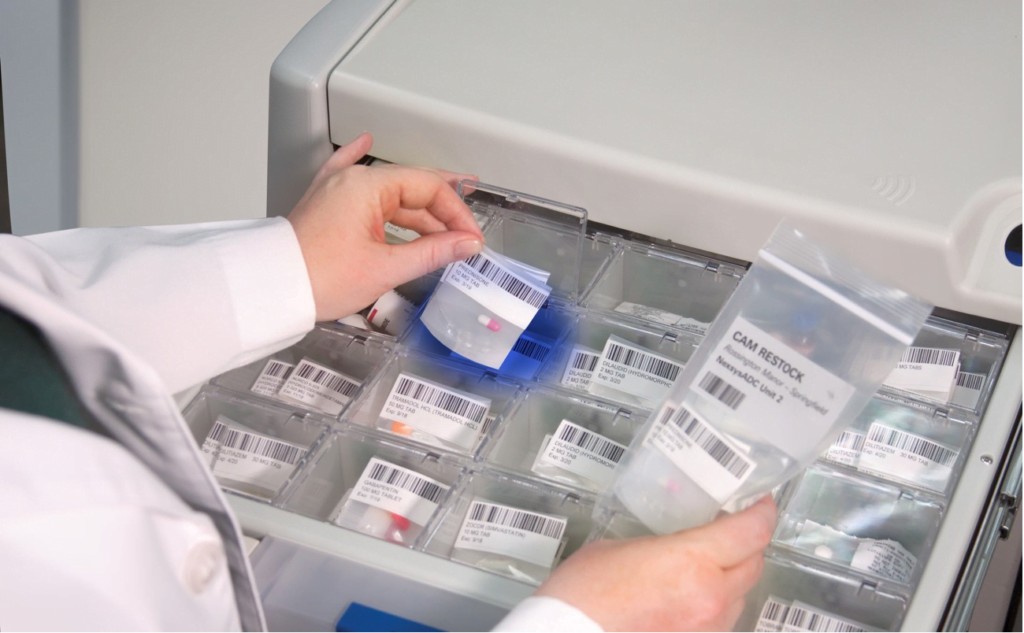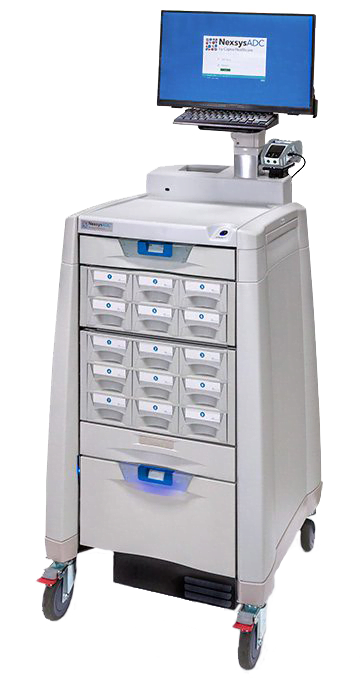
Automated dispensing cabinets (ADCs) are essential technology to streamline medication management, reduce medication errors, and enhance patient safety in a host of settings like long-term care homes, hospice, and behavioral health. Using the right ADC results in significant time savings and cost reduction.
Despite these apparent benefits, long-term care (LTC) facilities are slow to adopt these solutions. As a result, many still experience significant challenges with medication right-on-time availability, rising costs, and security. Drug diversion, for example, is an ongoing challenge. Between 2013 and 2021, 11,328.5 tablets were stolen from Minnesota LTC and nursing home residents alone, 97.5% of which were controlled substances.
However, strategic use of integrated technology and automated products can improve controlled medication security and reduce errors in LTCs while saving costs and improving resident care. In this blog, we will debunk misconceptions about the implementation and use challenges of ADCs and demonstrate the undeniable benefits, including cost savings and safety improvements, compared to manual medication storage and retrieval onsite in a long-term care facility.
Long-term care facilities and pharmacies are currently trailing behind hospitals and health systems regarding technological infrastructure and utilization. Over the years, facilities have been slow to adopt many forms of IT, from electronic health records to automated dispensing cabinets, for reasons such as:
However, manual and stationary medication management poses significant challenges that may outweigh any perceived drawbacks of ADC technology. Many facilities handle medications at the nursing station and dispense all drugs simultaneously during the med pass. Also, nurses may go back and forth between the patient and the nursing station to distribute meds.
The risk of medication errors with these practices is high. Staff may forget the dosing between trips, misplace medications, or document incorrectly, leading to overdoses or dispensing the wrong product to the wrong patient. All of these errors can negatively impact patient care.
Unfortunately, medication errors are common in LTC settings. A study of 25 nursing homes found that 92% of these sites reported 2,731 errors over one year. Of those errors, 8% seriously impacted patients and required intervention or monitoring.
The most common errors were missed doses, overdose, underdose, wrong strength, wrong patient, and wrong product.

Other data shows similar trends. An analysis of medication safety reports examined repeat errors in LTC facilities over two years. The study found that among the most common mistakes, 65% were a wrong dose, and 10% were incorrect administration. Errors were more common among older residents than younger, and repeat errors were more likely to be harmful.
It’s irrefutable that drug errors and medication challenges are dangerous, costly, and can directly affect resident care and nurses’ medication access precisely when needed. But, technology that reduces the potential for human error is essential for patient safety and better outcomes.
Industry partners Capsa Healthcare, and MAC Rx discuss ADCs as the logical solution for medication control in long-term facilities. Tune in to a webinar on October 18, 2023, with Jodie Vogt, Technology Services Manager at Capsa, and Miriam Cho, President and Chief Pharmacy Officer at MAC Rx, to learn about ADC strategies and advantages.
The healthcare industry has carefully capitalized on technology like automated dispensing machines in hospitals and other settings, using it in meaningful ways that benefit organizations, healthcare professionals, and patients alike.
Patients in LTC settings, especially older patients, may need several medications. While 42% of Americans over 65 take five or more prescription medications, more than 90% of long-term care residents take more than five medications and 65% take more than 10. As a result, nursing home residents are at a very high risk of experiencing severe drug side effects. ADCs simplify the medication dispensing process, streamlining it for better patient safety and a lower risk of errors.
ADCs safely store drugs and supplies in secure cabinets. These cabinets can be offered with tamper evidence technology, full user tracking, cloud-based inventory tracking, and electronic ordering. Nursing and pharmacy management know exactly which medications are in storage, who accessed them, and when they were dispensed for which resident.
The software integrates with your EHR and management systems, allowing better oversight of medication security and dispensing in facilities. You can track drug expiration dates and inventory turn rates, gaining more control over medication waste and loss of expensive inventory. Plus, ADCs give nurses and pharmacy staff more accurate drug handling, administration, and documentation, complete with audit trials.
The benefits of ADCs in strengthening medication safety and streamlining medication management are such that healthcare leaders and organizations are investing in these technologies. For example, the provincial government of Ontario, Canada, will fund $77 million to modernize medication systems for better handling and administration in long-term care homes throughout the province.
With easier medication management, ADCs also increase efficiency in medication workflow. Staff spend less time moving back and forth between residents and nursing stations or waiting for the pharmacy to deliver Stat medication doses. Instead, staff can securely store these frequently prescribed starter doses onsite and bring stored meds with them during a pass.
Additionally, staff spend less time manually documenting charts, instead making immediate updates to records via EHR integration. All healthcare workers involved in the resident’s care can stay up-to-date, eliminating miscommunications, errors, and inefficiencies. As a result, daily operations improve, and staff have more time to focus on residents.
Medication errors are a costly problem for LTC facilities. Reports suggest that for every dollar spent on drugs in LTC facilities, $1.33 is spent treating drug-related problems. Expired medication, billing issues related to manual management, and time lost in labor-intensive, outdated processes also contribute to a substantial financial burden.
ADCs can be cost-effective solutions that reduce medication and billing errors, missing paperwork, and expired medications. A study of seven nursing homes found a 91% reduction in dispensing errors after one year of using an automated system compared to previous manual practices.
With those significant reductions, LTC facilities can see substantial cost savings, even after considering the cost of implementing a new system. In turn, organizations have more resources to invest in resident care and new offerings.
Medical errors are an all-too-frequent occurrence; humans inevitably make mistakes. However, ADCs create stricter medication protocols with fewer workarounds that help reduce risk and human error.
User tracking from login to logout, biometric identification, remote inventory tracing, and audit logs give in-depth data on medication access, use, and control. Increased medication security and safety and fewer dispensing errors lead to improved quality care.
Additionally, ADCs create significant time savings for caregivers, freeing them to spend more time with residents. Staff can build meaningful relationships and interactions that improve residents’ living experiences and care.

hours. Contrary to popular belief, automated dispensing cabinets (ADCs), like the NexsysADC, can help control risk, provide insight into usage patterns and vulnerabilities, and reduce costs while improving quality outcomes and value.
NexsysADC™ Automated Dispensing Cabinet
Capsa Healthcare provides next-generation products and solutions that elevate performance and promote innovation in healthcare facilities. For over 60 years, we’ve pioneered medication management, pharmacy automation, and health IT solutions that improve workflows for a better bottom line.
We continue to innovate and help organizations achieve efficiency.